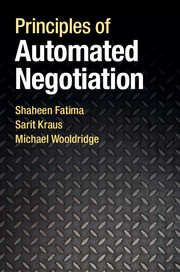Book contents
- Frontmatter
- Dedication
- Contents
- List of illustrations
- Preface
- Acknowledgements
- Summary of key notation
- 1 Introduction
- 2 Games in normal form
- 3 Games in extensive form
- 4 Negotiation domains
- 5 Strategic analysis of single-issue negotiation
- 6 Strategic analysis of multi-issue negotiation
- 7 The negotiation agenda
- 8 Multilateral negotiations
- 9 Heuristic approaches
- 10 Man–machine negotiations
- 11 Axiomatic analysis of negotiation
- 12 Applications
- 13 Related topics
- 14 Concluding remarks
- Appendix A Proofs
- References
- Index
5 - Strategic analysis of single-issue negotiation
Published online by Cambridge University Press: 05 November 2014
- Frontmatter
- Dedication
- Contents
- List of illustrations
- Preface
- Acknowledgements
- Summary of key notation
- 1 Introduction
- 2 Games in normal form
- 3 Games in extensive form
- 4 Negotiation domains
- 5 Strategic analysis of single-issue negotiation
- 6 Strategic analysis of multi-issue negotiation
- 7 The negotiation agenda
- 8 Multilateral negotiations
- 9 Heuristic approaches
- 10 Man–machine negotiations
- 11 Axiomatic analysis of negotiation
- 12 Applications
- 13 Related topics
- 14 Concluding remarks
- Appendix A Proofs
- References
- Index
Summary
In this chapter, we turn our attention to negotiation mechanisms – the protocols that will be used by agents when negotiating over domains of the type discussed in the preceding chapter. The first protocol we look at is concerned with negotiation over a single issue. Many real-world situations involve negotiation over a single issue. Typical examples include a buyer and a seller negotiating over the sale price of a commodity, a landlord and a tenant negotiating over the rental price of some accommodation, and an employer and an employee negotiating over the employee's salary. We will refer to the issue over which negotiation takes place as a “pie”, with the terminology arising from the analogy of a group of people negotiating about how to share a pie amongst themselves.
We know that, in order to negotiate, the parties must follow a protocol. There are many different protocols in the literature on negotiation, but arguably the most influential of these is the alternating offers protocol. This protocol was first analysed by Ingolf Stahl (1972) in the context of the division of a discretely divisible pie (i.e., a pie that can only be divided in a finite number of ways), and later by Ariel Rubinstein (1982) in the context of the division of a continuously divisible pie (i.e., any division of the pie is possible).
- Type
- Chapter
- Information
- Principles of Automated Negotiation , pp. 74 - 96Publisher: Cambridge University PressPrint publication year: 2014

